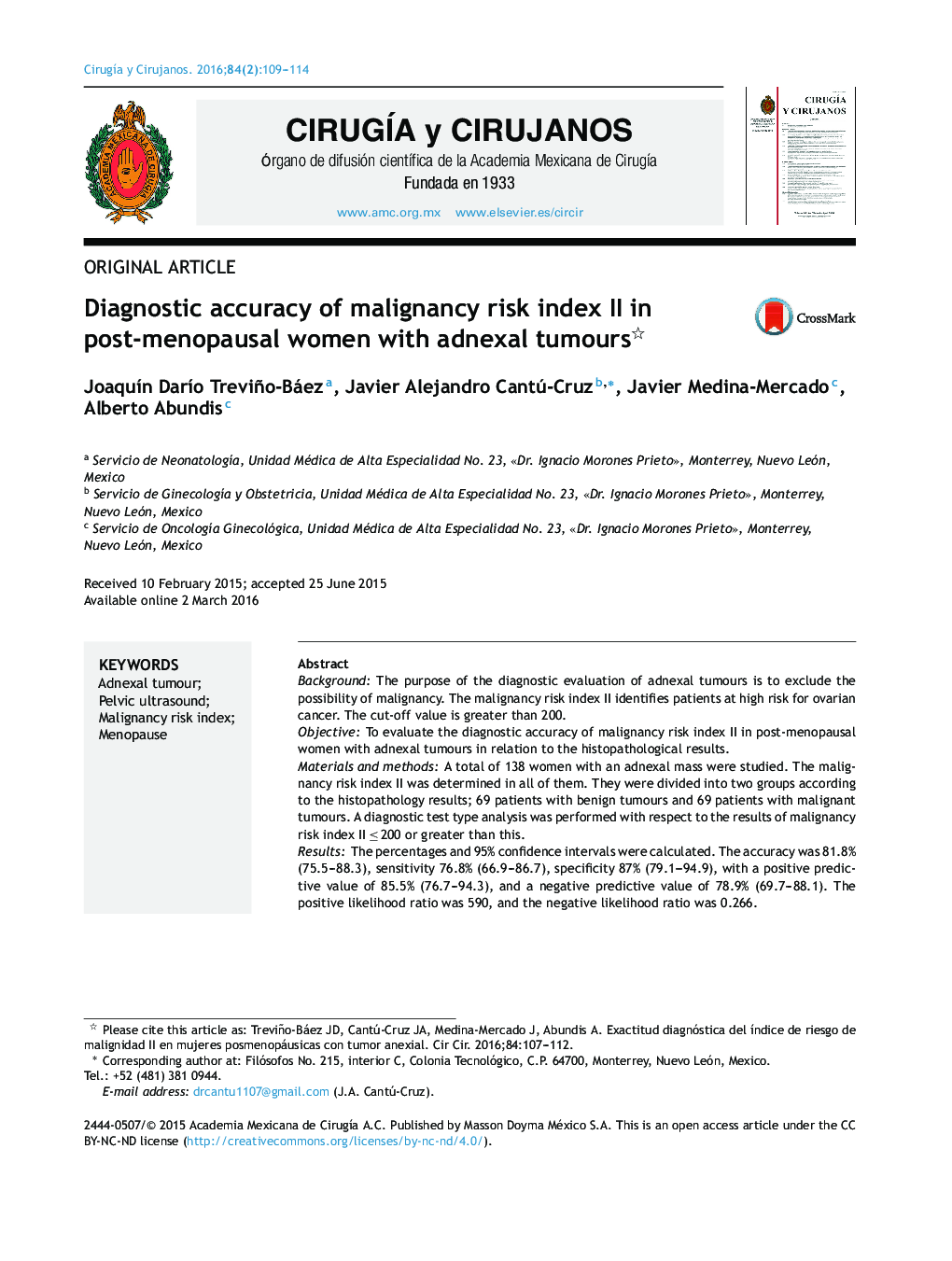| کد مقاله | کد نشریه | سال انتشار | مقاله انگلیسی | نسخه تمام متن |
|---|---|---|---|---|
| 4283329 | 1286881 | 2016 | 6 صفحه PDF | دانلود رایگان |

BackgroundThe purpose of the diagnostic evaluation of adnexal tumours is to exclude the possibility of malignancy. The malignancy risk index II identifies patients at high risk for ovarian cancer. The cut-off value is greater than 200.ObjectiveTo evaluate the diagnostic accuracy of malignancy risk index II in post-menopausal women with adnexal tumours in relation to the histopathological results.Materials and methodsA total of 138 women with an adnexal mass were studied. The malignancy risk index II was determined in all of them. They were divided into two groups according to the histopathology results; 69 patients with benign tumours and 69 patients with malignant tumours. A diagnostic test type analysis was performed with respect to the results of malignancy risk index II ≤ 200 or greater than this.ResultsThe percentages and 95% confidence intervals were calculated. The accuracy was 81.8% (75.5–88.3), sensitivity 76.8% (66.9–86.7), specificity 87% (79.1–94.9), with a positive predictive value of 85.5% (76.7–94.3), and a negative predictive value of 78.9% (69.7–88.1). The positive likelihood ratio was 590, and the negative likelihood ratio was 0.266.ConclusionsThe malignancy risk index II has good performance in the proper classification of post-menopausal women with adnexal masses, both benign and malignant, with an accuracy of 81.8%.
ResumenAntecedentesLa finalidad en la evaluación diagnóstica de los tumores anexiales es excluir la posibilidad de que se trate de un proceso maligno. El índice de riesgo de malignidad II, identifica a pacientes con alto riesgo de presentar cáncer de ovario. Su valor de corte es mayor de 200.ObjetivoEvaluar la exactitud diagnóstica del índice de riesgo de malignidad II en mujeres posmenopáusicas con tumor anexial.Material y métodosSe estudiaron 138 mujeres con diagnóstico de masa anexial. A cada una de ellas se le determinó el índice de riesgo de malignidad. Se dividieron en dos grupos de acuerdo a los resultados de histopatología; 69 pacientes con tumores benignos y 69 pacientes con tumores malignos. Se realizó un análisis tipo prueba diagnóstica con respecto a los resultados del índice de riesgo de malignidad II, en ≤ 200 o mayor a este.ResultadosLos siguientes porcentajes e intervalos de confianza del 95% fueron calculados, exactitud 81.8% (75.5–88.3), sensibilidad 76.6% (66.9–86.7), especificidad 87% (79.1–94.9), valor predictivo positivo 85.5% (76.7–94.3), valor predictivo negativo 78.9% (69.7–88.1). Se obtuvo una razón de verosimilitud positiva de 590 y razón de verosimilitud negativa de 0.266.ConclusionesEl índice de riesgo de malignidad II tiene una adecuada eficiencia en la clasificación de mujeres posmenopáusicas con tumor anexial, tanto benigno como maligno, con una exactitud de la prueba del 81.8%.
Journal: Cirugía y Cirujanos (English Edition) - Volume 84, Issue 2, March–April 2016, Pages 109–114